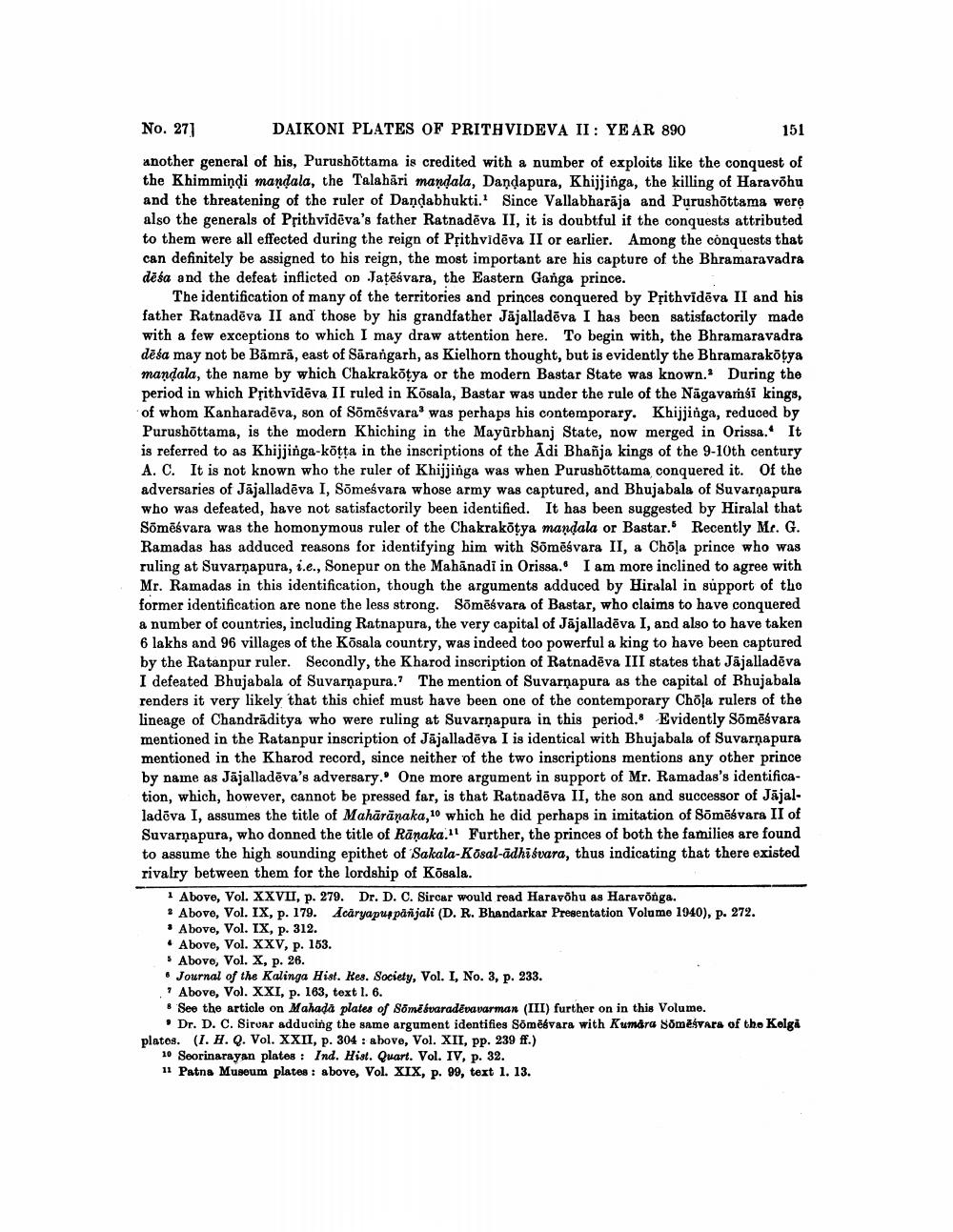________________
No. 27]
DAIKONI PLATES OF PRITHVIDEVA II: YEAR 890
151
another general of his, Purushottama is credited with a number of exploits like the conquest of the Khimminḍi mandala, the Talahari mandala, Dandapura, Khijjinga, the killing of Haravōhu and the threatening of the ruler of Dandabhukti. Since Vallabharaja and Purushottama were also the generals of Prithvideva's father Ratnadēva II, it is doubtful if the conquests attributed to them were all effected during the reign of Prithvidēva II or earlier. Among the conquests that can definitely be assigned to his reign, the most important are his capture of the Bhramaravadra deśa and the defeat inflicted on Jatesvara, the Eastern Ganga prince.
It
The identification of many of the territories and princes conquered by Prithvidēva II and his father Ratnadēva II and those by his grandfather Jäjalladēva I has been satisfactorily made with a few exceptions to which I may draw attention here. To begin with, the Bhramaravadra deśa may not be Bamra, east of Sarangarh, as Kielhorn thought, but is evidently the Bhramarakōtya mandala, the name by which Chakrakōtya or the modern Bastar State was known. During the period in which Prithvidēva II ruled in Kōsala, Bastar was under the rule of the Nagavaṁsi kings, of whom Kanharadeva, son of Sōmēs vara3 was perhaps his contemporary. Khijjinga, reduced by Purushottama, is the modern Khiching in the Mayurbhanj State, now merged in Orissa. is referred to as Khijjinga-kōṭṭa in the inscriptions of the Adi Bhañja kings of the 9-10th century A. C. It is not known who the ruler of Khijjinga was when Purushottama, conquered it. Of the adversaries of Jajalladēva I, Sõmeśvara whose army was captured, and Bhujabala of Suvarnapura who was defeated, have not satisfactorily been identified. It has been suggested by Hiralal that Sōmēsvara was the homonymous ruler of the Chakrakōtya mandala or Bastar. Recently Mr. G. Ramadas has adduced reasons for identifying him with Sōmēśvara II, a Chōla prince who was ruling at Suvarnapura, i.e., Sonepur on the Mahanadi in Orissa. I am more inclined to agree with Mr. Ramadas in this identification, though the arguments adduced by Hiralal in support of the former identification are none the less strong. Sōmēsvara of Bastar, who claims to have conquered a number of countries, including Ratnapura, the very capital of Jājalladēva I, and also to have taken 6 lakhs and 96 villages of the Kōsala country, was indeed too powerful a king to have been captured by the Ratanpur ruler. Secondly, the Kharod inscription of Ratnadeva III states that Jājalladeva I defeated Bhujabala of Suvarnapura. The mention of Suvarnapura as the capital of Bhujabala renders it very likely that this chief must have been one of the contemporary Chōla rulers of the lineage of Chandraditya who were ruling at Suvarnapura in this period. Evidently Sōmēsvara mentioned in the Ratanpur inscription of Jajalladeva I is identical with Bhujabala of Suvarnapura mentioned in the Kharod record, since neither of the two inscriptions mentions any other prince by name as Jājalladeva's adversary. One more argument in support of Mr. Ramadas's identification, which, however, cannot be pressed far, is that Ratnadēva II, the son and successor of Jajalladēva I, assumes the title of Mahārāṇaka,10 which he did perhaps in imitation of Sōmesvara II of Suvarnapura, who donned the title of Ranaka." Further, the princes of both the families are found to assume the high sounding epithet of Sakala-Kōsal-adhisvara, thus indicating that there existed rivalry between them for the lordship of Kōsala.
1 Above, Vol. XXVII, p. 279. Dr. D. C. Sircar would read Haravõhu as Haravōnga.
2 Above, Vol. IX, p. 179. Acaryapuṛpañjali (D. R. Bhandarkar Presentation Volume 1940), p. 272. Above, Vol. IX, p. 312.
• Above, Vol. XXV, p. 153.
Above, Vol. X, p. 26.
Journal of the Kalinga Hist. Res. Society, Vol. I, No. 3, p. 233.
7 Above, Vol. XXI, p. 163, text 1. 6.
See the article on Mahada plates of Sōmesvaradevavarman (III) further on in this Volume.
Dr. D. C. Sircar adducing the same argument identifies Sōmēévara with Kumara Sōmēsvara of the Kelgä plates. (I. H. Q. Vol. XXII, p. 304: above, Vol. XII, pp. 239 ff.)
10 Seorinarayan plates: Ind. Hist. Quart. Vol. IV, p. 32.
11 Patna Museum plates: above, Vol. XIX, p. 99, text 1. 13.




